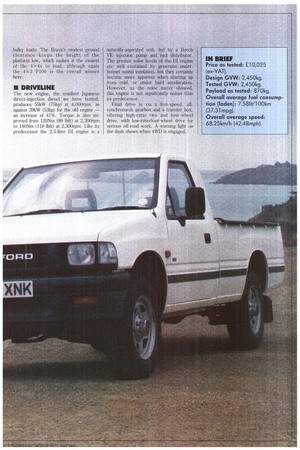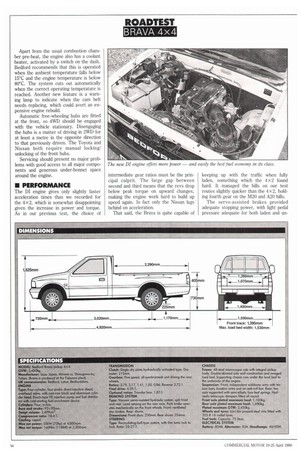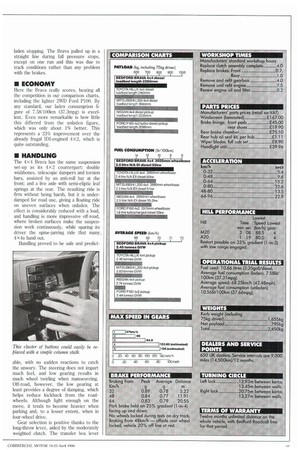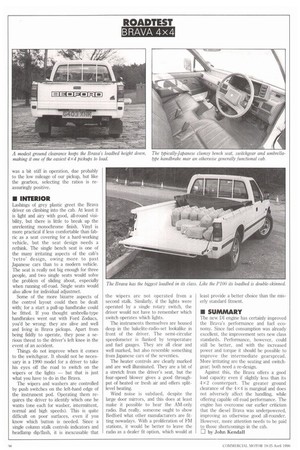• Nothing stands still for long. When we tested the
Page 36

Page 37

Page 38

Page 39

Page 40

If you've noticed an error in this article please click here to report it so we can fix it.
4x2 Bedford Brava last year (CM 26 January-1 February 1989) it was powered by a 2.2-litre indirect-injection diesel engine. Now, just over 12 months later, this Japanese-built Isuzu range has been equipped with a new 2.5-litre directinjection unit. This time around we assess the 4x4 model.
So far none of its main competitors in the 4x4 one-tonne sector offers a directinjection unit, although the indirect engines they do provide give similar levels of power and torque.
In our comparison charts we have included the Ford P100, which does not
offer the same off-road performance but is the most popular 4x2 one-tonne pickup in the UK, and offers similar power and torque from an engine some 700cm3 smaller. It is also worth noting that in terms of basic bodyshell and power train, the Toyota Hilux and the VW Taro are identical.
The Brava is the most expensive in this company with an ex-VAT price of £10,025. The Nissan follows closely behind at £9,995, while the Toyota, VW and Mitsubishi L200 differ only slightly. The Toyota is more expensive, at £9,896 against the VW at £9,862 and the Mitsubishi at £9,809. The P100 in standard turbo form is the cheapest at £7,482.
The 4x4 Brava differs from its 4x2 counterpart with larger 205 section tyres on 6.00 J 16in steel rims which account for the slightly-increased ground clearance. In other respects it is the same except, as with other 4x4 pickups, its carrying capacity has been reduced by the additional weight of the drivetrain parts in the Brava's case, down from 1,060kg to 870kg. The Brava gives a better payload than the Toyota Hilux but is beaten by the Mitsubishi L200 and Nissan 4 x4. However, the Brava does offer the best load area in its class, so scores well for bulky loads. The Brava's modest ground clearance keeps the height of the platform low, which makes it the easiest of the 4x4s to load, although again the 4 x 2 P100 is the overall winner here.
11 DRIVELINE
The new engine, the smallest Japanese direct-injection diesel we have tested, produces 55kW (75hp) at 4,000rpm, as against 39kW (53hp) for the old engine — an increase of 41%. Torque is also improved from 120Nm (89 lbft) at 2,200rpm to 160Nrn (118 lbft) at 2,300rpm. Like its predecessor the 2.5-litre DI engine is a
naturally-aspirated unit, fed by a Bosch VE injection pump and fuel distributor. The greater noise. levels of the DI engine are well contained by generous underbonnet sound insulation, but they certainly• become more apparent when starting up from cold, or under hard acceleration. However, as the noise meter showed, this engine is not significantly noiser than its predecessor.
Final drive is via a five-speed, allsynchromesh gearbox and a transfer box, offering high-ratio two and four-wheel drive, with low-ratio/four-wheel drive for serious off-road work. A warning light on the dash shows when 4WD is engaged. Apart from the usual combustion chamber pre-heat, the engine also has a coolant heater, activated by a switch on the dash. Bedford recommends that this is operated when the ambient temperature falls below 15°C and the engine temperature is below 80°C. The system cuts out automatically when the correct operating temperature is reached. Another new feature is a warning lamp to indicate when the cam belt needs replacing, which could avert an expensive engine rebuild.
Automatic free-wheeling hubs are fitted at the front, so 4WD should be engaged with the vehicle stationary. Disengaging the hubs is a matter of driving in 2W1) for at least a metre in the opposite direction to that previously driven. The Toyota and Nissan both require manual locking/ unlocking of the front hubs.
Servicing should present no major problems with good access to all major components and generous under-bonnet space around the engine.
• PERFORMANCE
The DI engine gives only slightly faster acceleration times than we recorded for the 4x 2, which is somewhat disappointing given the increase in power and torque. As in our previous test, the choice of intermediate gear ratios must be the principal culprit. The large gap between second and third means that the revs drop below peak torque on upward changes, making the engine work hard to build up speed again. In fact only the Nissan lags behind on acceleration.
That said, the Brava is quite capable of keeping up with the traffic when fully laden, something which the 4x2 found hard. It managed the hills on our test routes slightly quicker than the 4x2, holding fourth gear on the M20 and A20 hills.
The servo-assisted brakes provided adequate stopping power, with light pedal pressure adequate for both laden and un laden stopping. The Brava pulled up in a straight line during full pressure stops, except on one run and this was due to track conditions rather than any problem with the brakes.
• ECONOMY
Here the Brava really scores, beating all the competition in our comparison charts, including the lighter 2WD Ford P100. By any standard, our laden consumption figure of 7.58/100km (37.3mpg) is excellent. Even more remarkable is how little this differed from the unladen figure, which was only about 1% better. This represents a 23% improvement over the already frugal ID1-engined 4x2, which is quite outstanding.
• HANDLING
The 4x4 Brava has the same suspension set-up as its 4x2 counterpart: double wishbones, telescopic dampers and torsion bars, assisted by an anti-roll bar at the front; and a live axle with semi-efiptic leaf springs at the rear. The resulting ride is firm without being harsh, but it is underdamped for road use, giving a floating ride on uneven surfaces when unladen. The effect is considerably reduced with a load, and handling is more impressive off-road, where broken surfaces make the suspension work continuously, while sparing its driver the spine-jarring ride that many. 4x4s hand out.
Handling proved to be safe and predict able, with no sudden reactions to catch the unwary. The steering does not impart much feel, and low gearing results in much wheel twirling when manoeuvring. Off-road, however, the low gearing at least provides a degree of damping, which helps reduce kickback from the roadwheels. Although light enough on the move, it tends to become heavier when parking and, to a lesser extent, when in four-wheel drive.
Gear selection is positive thanks to the long-throw lever, aided by the moderately weighted clutch. The transfer box lever was a bit stiff in operation, due probably to the low mileage of our pickup, but like the gearbox, selecting the ratios is reassuringly positive.
• INTERIOR
Lashings of grey plastic greet the Brava driver on climbing into the cab. At least it is light and airy with good, all-round visibility, but there is little to break up the unrelenting monochrome finish. Vinyl is more practical if less comfortable than fabric as a seat covering for a hard-working vehicle, but the seat design needs a rethink. The single bench seat is one of the many irritating aspects of the cab's 'retro' design, owing more to past Japanese cars than to a modern vehicle. The seat is really not big enough for three people, and two single seats would solve the problem of sliding about, especially when running off-road. Single seats would also allow for individual adjustmet.
Some of the more bizarre aspects of the control layout could then be dealt with; for a start a pull-up handbrake could be fitted. If you thought umbrella-type handbrakes went out with Ford Zodiacs, you'd be wrong: they are alive and well and living in Brava pickups. Apart from being fiddly to operate, they pose a serious threat to the driver's left knee in the event of an accident.
Things do not improve when it comes to the switchgear. It should not be necessary in a 1990 model for a driver to take his eyes off the road to switch on the wipers or the lights — but that is just what you have to do in the Brava.
The wipers and washers are controlled by push switches on the left-hand edge of the instrument pod. Operating them requires the driver to identify which one he wants (one each for washer, intermittent, normal and high speeds). This is quite difficult on poor surfaces, even if you know which button is needed. Since a single column stalk controls indicators and headlamp dip/flash, it is inexcusable that the wipers are not operated from a second stalk. Similarly, if the lights were operated by a single rotary switch, the driver would not have to remember which switch operates which lights.
The instruments themselves are housed deep in the bakelite-radio-set lookalike in front of the driver. The semi-circular speedometer is flanked by temperature and fuel gauges. They are all clear and well marked, but also resemble something from Japanese cars of the seventies.
The heater controls are clearly marked and are well illuminated. They are a bit of a stretch from the driver's seat, but the four-speed blower gives a good throughput of heated or fresh air and offers splitlevel heating.
Wind noise is subdued, despite the large door mirrors, and this does at least make it possible to hear the AM-only radio. But really, someone ought to show Bedford what other manufacturers are fitting nowadays. With a proliferation of FM stations, it would be better to leave the radio as a dealer fit option, which would at least provide a better choice than the miserly standard fitment.
• SUMMARY
The new DI engine has certainly improved the Brava's performance and fuel economy. Since fuel consumption was already excellent, the improvement sets new class standards. Performance, however, could still be better, and with the increased power and torque it should be possible to improve the intermediate gearspread. More irritating are the seating and switchgear; both need a re-design.
Against this, the Brava offers a good load capacity even if slightly less than its 4x2 counterpart. The greater ground clearance of the 4x4 is marginal and does not adversely affect the handling, while offering capable off-road performance. 'Ile engine has overcome our earlier criticism that the diesel Brava was underpowered, improving an otherwise good all-rounder. However, more attention needs to be paid to those shortcomings in the cab.
by John Kendall








































































































































